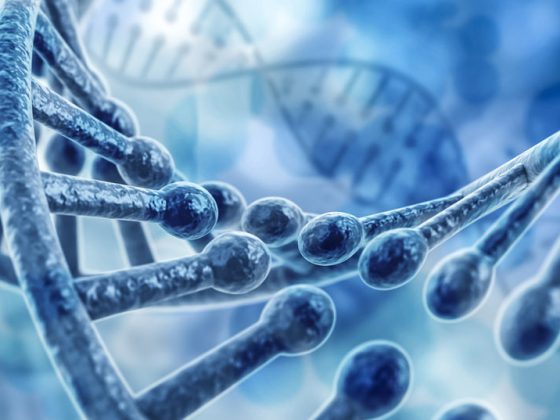Will there soon be a once-daily tablet that will eliminate the need for chemotherapy for malignant hematologic diseases such as acute myeloid leukemia? This question is being investigated in an ongoing phase I study presented at the ASH Congress in San Francisco (and previously at the EHA Congress in Milan). The preliminary results give hope.
The compound that is causing movement in the field of hematologic malignancies is called AG-221. This is the first representative of a new class of drugs: oral, reversible, selective inhibitors of the IDH2 mutation. Mutations in the metabolic enzymes isocitrate dehydrogenase 1 and 2 (IDH1/IDH2) have been identified in a wide spectrum of solid tumors and malignant hematologic disorders:
- IDH2 mutations are found in approximately 9-13% of patients with acute myeloid leukemia (AML) and in 3-6% of patients with myelodysplastic syndrome (MDS).
- IDH1 mutations are found in approximately 6-10% of AML patients and in 3% of patients with MDS.
The mutations cause accumulation of the oncometabolite 2-hydroxyglutarate (2-HG), which in turn has a cancer-promoting effect. New data from the ongoing phase I trial were presented at the ASH congress, giving great hope that a non-cytotoxic approach could eventually make chemotherapy-free treatment of AML, for example, possible.
What is the right dose for phase II?
Patients with malignant hematologic disease and confirmed IDH2 mutation (untreated, refractory or relapsed AML or MDS) were included. They received the new inhibitor once or twice daily in monthly cycles (28 days). Since the aim was also to find the maximum tolerable dose (MTD), the first cohort started with 2× 30 mg/d and gradually increased the dose regimen. Since the study began in September 2013, the drug has been administered to a total of 73 patients – including those who took the drug once or twice a day, sometimes in cumulative doses of up to 300 mg/d. Four expansion cohorts were recruited by October 2014 (1× 100 mg/d). The aim is to find the adequate dose for a later phase II trial. Dosage escalation continues.
The 73 patients had a median age of 67 years, and the vast majority suffered from relapsed or refractory AML (55 subjects). The gender distribution was balanced. Most patients had an ECOG performance status of 1 (limitation of physical exertion, ambulatory, light physical work possible), so they were in relatively good condition. ECOG status above 2 (ambulatory, able to care for self but unable to work, able to stand up more than 50% of waking hours) was not found in anyone.
Bone marrow examinations were performed on days 15, 29, 57, and every 56 days thereafter. Primary concerns were safety and dose finding for subsequent studies. Secondarily, clinical activity and pharmacokinetics and dynamics were investigated with respect to 2-HG, and efficacy data should be interpreted as preliminary.
Good compatibility
The pleasing thing: Tolerability is consistently good and the MDT has not yet been reached. Grade 1 and 2 adverse events were most common and included nausea, fever, diarrhea, and fatigue (all disease- rather than therapy-associated). Grade 5 hypoxia (2× 100 mg/d) occurred but was not related to medication. Of eleven deaths, nine were therapy-independent and only two cases (one sepsis/hypoxia, one atrial flutter) could not be ruled out as being drug-related. A total of 13 patients were found to have 21 serious, possibly drug-associated adverse events, including leukocytosis, disseminated intravascular coagulopathy, and tumor lysis syndrome. According to the authors, severe leukocytosis in particular needs to be kept in mind.
Regarding pharmacokinetics/dynamics, previous analyses showed good uptake of AG-221 for doses of 2× 30- 75 mg/d or 1× 100 mg/d. Accumulation was high after multiple doses and the average plasma half-life was >40 hours. Pharmacodynamically, there was sustained suppression of 2-HG, in some cases greater than 90%, particularly in patients with an IDH2-R140 mutation. This in turn promotes differentiation of the blasts, turning them into functional, mature blood cells. Preclinical models had already pointed to the completely novel approach to AML treatment.
Overall response of 56
Efficacy could also be tested in 45 of the 73 patients recruited. Six of these had a complete response and ten had a partial response. Four responded completely in the bone marrow readout (<5% blasts) but did not recover hematologically. Four showed a complete response without complete platelet recovery (“complete response, incomplete platelet recovery”, CRp), one a complete response without hematologic recovery (“complete response, incomplete hematologic recovery”, CRi). The overall response rate calculated from this was 56% (25 of the 45 patients, 95%CI 40-70%) – according to the authors, a very impressive result in this difficult-to-treat population. Response was best in the group receiving a cumulative daily dose of 100 mg. This was also the reason for recruiting the four expansion cohorts at this dose. The disease of 17 patients was stable, with progression in only two.
Enthusiastic basic mood
Based on the promising results, the authors see the inhibitor as a potential future therapeutic option for advanced malignant hematologic diseases. The response is very good and apparently durable: over eight months in the observed study period and still persisting at the time of presentation. “This is impressive and gives us hope,” said study leader Eytan M. Stein, MD, New York. Some patients hospitalized at the beginning are now even at home and going about their normal activities, he said.
Other experts at the ASH Congress agreed with this opinion, saying that the results were indeed excellent in terms of response and safety. However, it was also emphasized that one must now wait for the following study phases and should not be blinded by the current enthusiasm.
Source: 56th ASH Annual Meeting, December 6-9, 2014, San Francisco.
InFo ONCOLOGY & HEMATOLOGY 2015; 3(2): 26-28.












